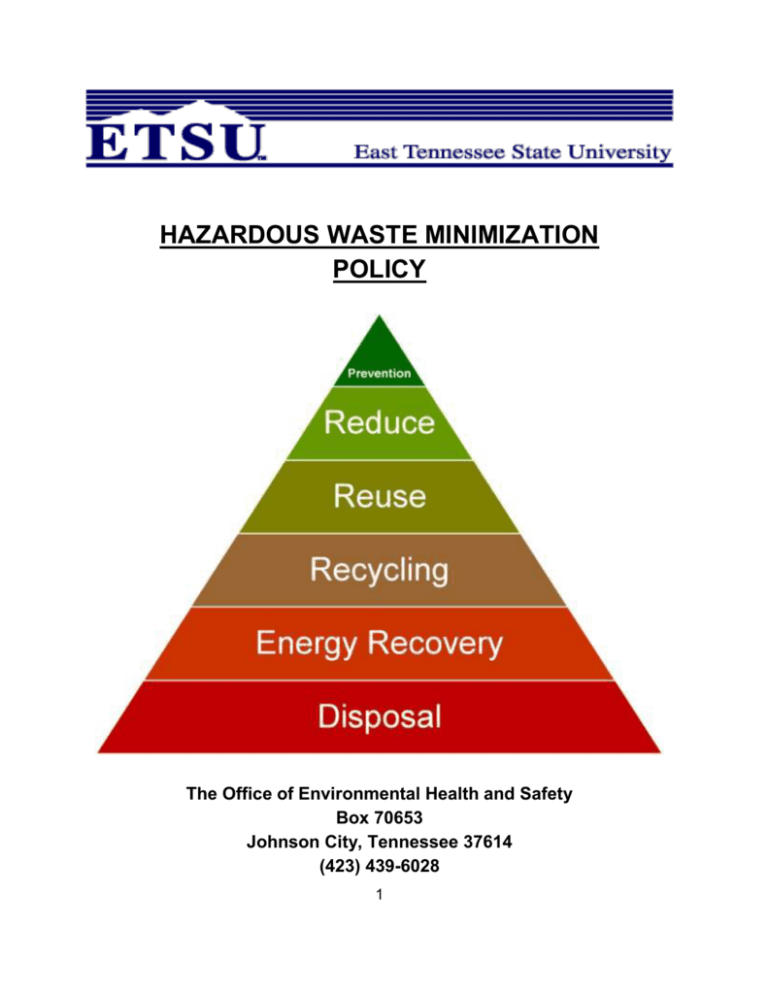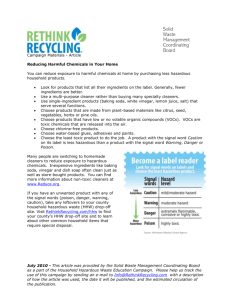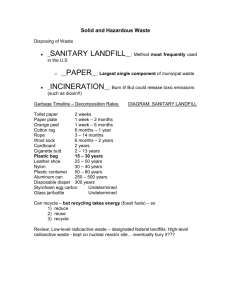ETSU Hazardous Waste Minimization Policy
advertisement

HAZARDOUS WASTE MINIMIZATION POLICY The Office of Environmental Health and Safety Box 70653 Johnson City, Tennessee 37614 (423) 439-6028 1 Administrative Endorsement Hazardous Waste Reduction East Tennessee State University is committed to providing direction and leadership by the implementation of measures to protect and preserve our environment and to conserve our decreasing natural resources. In keeping with this commitment, I hereby establish the policy that ETSU will minimize the amount of hazardous waste we generate through an aggressive source reduction program. Where reduction cannot be achieved at the source, we will advocate the recycling and reuse of the waste. Since our efforts will only be effective through cooperative support and active participation, I hereby charge all university staff, faculty and student personnel to provide their assistance in helping the university meet it’s stated objective. ______________________ Daniel O’Brien Director for Environmental Health & Safety 2 ___________ Date Scope This Plan has been developed to meet the requirements of the Tennessee Hazardous Waste Reduction Act of 1990 (TCA 68-212-301). The waste reduction concepts apply to East Tennessee State University and the Quillen College of Medicine facilities located on the James H. Quillen VA Medical Center. Objectives This plan provides the guidance framework to ensure that the generation of all hazardous wastes by the university is limited to the minimum amount, which is technically practicable and economically feasible. This Plan will help to maintain an awareness of the hazardous waste generated throughout the university and ensure an on-going review and analysis of applicable reduction factors. An effective waste reduction program lowers liability risks, operating and research costs, as well as, hazardous waste administrative and disposal costs. Review and Analysis This plan, as well as new waste reduction technologies, procedures, and economic feasibility of alternatives, will be reviewed at least annually. Waste Reduction Methodologies Currently in Place East Tennessee State University has implemented several waste reduction programs and technologies which have greatly reduced the volume and toxicity of chemical wastes produced. These methods, centered on the traditional techniques of waste abatement, waste minimization and reuse/recycle are described below. Source Reduction: Changing practices and processes in order to reduce or eliminate the generation of hazardous waste is the most preferable option in the waste management hierarchy. Source reduction can be accomplished through: 1. Effective purchasing 2. Chemical substitution 3. Conducting experiments at the micro-scale 4. Good housekeeping Product Substitution: Non-hazardous or the least toxic materials possible, are used in production areas, chemical processes, and throughout academic and research laboratories. Specific examples include: All laboratories use detergent and enzymatic cleaners instead of sulfuric acid/potassium dichromate cleaning solutions. 3 Known or suspected carcinogens, mutagens, or extremely hazardous chemicals are restricted to those areas where they are necessary for research. Non-hazardous water based paints are predominately used throughout the campus. Solvent or toxic metal-based paints are restricted to those surfaces that require a very durable finish. Non-toxic, water reducible epoxy paints are currently used in animal care/animal research areas that were previously painted with more toxic finishes. Micro-scale analysis and increased use of Instrumentation: All teaching and research laboratories use micro-analytical techniques. This practice reduces the volume of starting materials and waste generated by a factor between 100 and 1,000. Chemical Redistribution: Unopened or unused portions of chemicals are redistributed within the university campus. Chemicals are redistributed independently from department to department, or with assistance from the Environmental Health & Safety Office. Waste Minimization: The reduction of the quantity of waste through good housekeeping practices or by the application of concentration technology. Purchasing: University ordering and delivery systems eliminate the need for large stockpiles of chemicals within laboratories. Departments and clinics that are the largest users of hazardous chemicals on campus have "on-line" ordering capability with either Sigma/Aldrich or Fisher Scientific. Orders are submitted for the smallest unit quantities available or that's most suitable for each particular need. EH&S reviews and must approve these chemical purchases through this online procurement process. Segregation and Characterization: Precautions are taken to ensure that hazardous wastes are not mixed with nonhazardous waste. All waste containers are labeled as to their content and in the case of mixtures, the approximate percentage of each component is listed. Hazardous Waste Characterization by ETSU Waste Xylene: Laboratories performing cell tissue research generate this waste. Xylene is used to "dry" cell tissues for subsequent paraffin imbedding and slide mounting. The Department of Pathology currently recycles over 95% of this waste for reuse within the Department. Has not been a waste stream since 2004 but is still open. 4 Waste Silver: Waste silver is a component in used photographic fixer. This waste is generated from those areas that have medical/dental x-ray units, photography labs and studios. Fixer from all but small laboratories and the Art Department is collected by “inline” filtration and recycled by and outside vendor. Spent Solvents: The chemicals, which make up this waste stream, are generated by most laboratories, which perform HPLC analysis. Significant increases in generation occur when old/excess chemicals inventories are discarded. This waste stream is utilized to reduce costs by pouring compatible chemicals into a 55 gallon drum. Lab-packed Chemicals: Lab packs are official packaging units recognized by the U.S. DOT. They are the most appropriate way to ship waste laboratory chemicals, because they allow different materials in the same hazard class to be packaged together. Lab pack containers range from 55-gallon containers to 5-gallon pails. Containers are filled with small containers of chemicals packed in and separated by vermiculite. Most all lab packed chemical wastes are incinerated with the exception of mercury and other heavy metal wastes that are reclaimed through treatment. Acids and oxidizers are neutralized when possible. Waste Paint: This waste results from the painting operations by Facilities and from painting classes in the Art Department. Lead Waste: The ETSU rifle range is cleaned annually in order to remain safe and useable by ROTC and other departments. Each cleaning generates differing amounts of lead contaminated debris which is managed as regulated waste and brass and lead which are recycled. Mixed Radiological Waste: This waste, generated primarily by the COM results from the mixture of radioisotopes and xylene or toluene solvents. Still Bottoms: This waste results form the distillation of the used xylene in Pathology. Paraffin Contaminated with Xylene: This waste is generated by pathology from the liquid paraffin used to fix tissue. 5 Hazardous Waste Generation Tables 1 and 2 show the amount of hazardous waste generated by East Tennessee State University and the Quillen College of Medicine since 2005. The total amount of waste generated ranged from approximately 2,500 kg to 6,000 kg per year. This wide range is due somewhat to the diversity of research, but primarily to the disposal of outdated/excess chemical inventories. Waste Generation Reductions/Actions/Goals Waste Silver: Dark rooms in University Relations have been converted to digital formats. Review all remaining generators and see if their developing operations may be closed, merged with other dark rooms, or converted to a digital process. Naphtha Waste, Compound Cleaner, and Brake Cleaner: These streams are no longer generated as hazardous wastes. In July 2004, ETSU switched to Crystal Clean for our parts washers contract. Crystal Clean uses these wastes as ingredients for manufacturing roofing materials which allows an exemption to the listing as a hazardous waste. These solvents have been tested for metals and no metals were detected. Mixed Radiological Waste: In 2003 all laboratories were prohibited from using flammable solvents and instructed to use only biodegradeable solvents. Lead Waste: The ETSU rifle range is cleaned on an annual basis. Cleaning procedures and waste generation will be evaluated each year and any necessary adjustments made. Waste Paints (Art Dept.): No reduction efforts are planned for this waste stream this year because of its low volume, approximately 25 gallons per year. Action will be taken to review the content of the waste to see if separation into hazardous and nonhazardous components is feasible. Mercury: This waste stream has increased since 2007 due to the emphasis on making ETSU a mercury free campus. In 2010 a Mercury Thermometer Replacement Program was initiated that urged the purchasing of alternative non-mercury thermometers and other mercury containing equipment. 6 Table 1 Hazardous Waste Generated by ETSU 2005-2011 Waste Stream # 8 8 24 30 31 32 34 35 36 37 39 40 Waste Stream Name Waste Silver, treated onsite Waste Silver, treated offsite Lab-Packed Chemicals Waste Paints, Facilities Spent Solvents Waste Paints, Art Dept. Lead Waste Waste Mercury Mixed Rad. Waste Waste Aerosols Solvent Cont. Silica Gel Metals Cont. Debris 41 42 Waste Gas Cont. Debris Waste Trichlorofluoromethane TOTAL (#s) 2005 2006 2007 2008 2009 2010 2011 1491 928 825 0 88 300 31 37 - 1480 972 2653 1031 0 249 348 0 0 - 1400 2250 3935 855 900 45 220 110 402 200 150 - 1400 1900 1830 900 1550 0 170 90 312 20 180 150 0 1400 2810 1900 2800 0 330 105 0 65 200 - 0 950 1430 1175 1350 0 1000 85 0 5 0 - - - - - 100 1800 3570 1250 1250 200 430 5 0 165 175 WS Closed 450 - 0 - 0 150 3700 6733 10467 8190 9395 9610 6145 7 Table 2 Hazardous Waste Generated by COM January 2005-2011 Waste Waste Stream 2005 2006 2007 2008 2009 2010 2011 Stream # Name 2 Lab-Packed Chemicals 557 1062 1365 1140 1655 790 925 3 Mixed Rad. Waste 59 0 0 0 16 0 0 4 Spent Solvents 0 198 0 400 450 0 0 5 Mercury 0 0 10 10 15 15 27 8 Waste Still Bottoms 26 0 25 0 20 0 0 9 Waste Aerosols 9 0 0 0 0 60 10 10 Waste Fixer 9 0 0 0 0 0 0 11 Waste Paraffin 112 119 120 0 120 0 0 12 Waste Paint Thinners & Strippers 250 0 0 TOTAL(#s) 772 1199 1520 1550 2526 865 962 8








